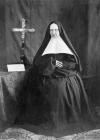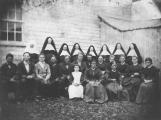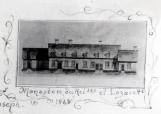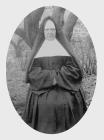2
The arrival of the nuns to look after the lepersHaving understood that there was but one way to look after the material and moral needs of the lepers; Mgr. Rogers entrusted this task to the nuns. A new building was built onto the existing hospital to serve as a convent for the nuns. Montreal's Religious Hospitallers of Saint Joseph were called upon to perform this duty. Six nuns arrived in Tracadie on September 29th, 1868. They were under the direction of mother Marie Pagé. Their first year was difficult as they received no funds from the government until the following year. Their survival depended on the charity of the parishioners and the generosity of the vicar-general. who was the pastor of Caraquet. Father Paquet had authorized them to take what they needed from the merchants and had taken responsability for paying their debts. The government gave them only 200 dollars the following year. Tracadie's pastor, father Gauvreau, gave 15 acres of farming land to the sisters in 1869. A barn was built by the parishioners. They also had the chore of providing firewood for the nuns. Father Gauvreau was indeed a benefactor to the nuns. Near the end of 1873, the nuns opened a school with the help of their benefactors, like the Honourable W. Davidson, father Babineau and the parishioners.
A few days later, 64 students were enrolled and their number rose to 180 the following school year.
4
Mgr. James Rogers1826-1903
Mgr. James Rogers was the first bishop of the new diocese of Chatham which covered the Northern Territories of New Brunswick. He was the only son of John Rogers and Mary Britton. He was born in Ireland on July 11th, 1826 and emigrated with his parents to Halifax in 1831. He began his theological studies at the seminary of the Sulpiciens in Montreal. He became fluent in French during that time. He was ordained in Halifax by Mgr. Walsh on July 2nd 1851. He was named pastor of Church Point, Nova Scotia. As a priest, he lacked neither self-assurance, zeal, nor joviality. This allowed him to solidify the Church's presence by preaching in both English and French, as well as in Mic-Mac occasionally.
He was sent to the Bermudas in 1857 where he was responsible for the building of the first Catholic church in the islands. He then acted as secretary for the archbishop, as well as taught at Saint Mary's College when he was recalled in 1859. Rogers was named bishop of Chatham on May 8th, 1860. He received his episcopal ordination in Charlottetown on August 15th, 1860.
The young pastor found in his congregation the perfect match for his zeal and his energy : a vast diocese with 60 missions with only 8 priests to attend to their needs. The quarantined lepers of the region in Tracadie's lazaretto, immediately gained his compassion. He took steps to bring to the area a religious congregation from Montreal to take care of the lepers and of the sick. He endowed the parish with schools, hospitals and priests as the years passed. As he was totally devoted to his duty, he had the courage and capacity to look after the parish with energy and foresight. After 42 years as bishop, Mgr. Rogers died in Chatham's Hôtel-Dieu on March 22nd, 1903.
6
Monastery and the lazaretto at the arrival of the Religious Hospitallers of Saint Joseph in 1868To make space for the sisters, the Board of Health did some repairs and added an extension to the lazaretto before the arrival of the nuns."The new building was 42 feet in length by 25 feet in width and 30 feet in height. Attic windows were fitted up under the roof which made space for 5 little bedrooms, while the ground floor was divided in 4 parts".
8
Joseph Auguste Babineau, 1844-1915Joseph Auguste Babineau was born in Saint Louis de Kent, New Brunswick, April 29th, 1844. He is called upon to replace pastor Gauvreau in the parish of Tracadie September 9th, 1871. Father Babineau's immediate goal was to finalize the procedures for the construction of a new stone church. The construction began in 1874 and ended in 1896. Shortly thereafter, a presbytery was constructed. The nuns managed to have the stone lazaretto (1896) built thanks to his support and his aid.
The nuns and the doctor assumed the responsibility of taking care of the lepers when the admnistration of the lazaretto was transferred from the provincial Bureau of Health to the federal government in 1880. Father Babineau was nonetheless named as its director and signed the agreement.
He made several trips to Ottawa to obtain both the construction of a new building and an increase in the annual allocation given to the nuns in order to take care of the sick. Father Babineau acted as the lazaretto's protector and was its supporter taking to heart its interests during his 32 years of service in the parish of Tracadie. The lazaretto was fortunate to have such a zealous supporter. He was named pastor in St.
Leonard in the spring of 1903. He would remain there until his death, March 31st, 1915.
9
Mother Marie Pagé, founder and superior of the lazaretto at Tracadie1868
Tracadie, New Brunswick, Canada

10
Sister Marie Pagé, 18811-1893, superior and founder of the Mission at TracadieFounder and Mother Superior of Tracadie's mission, sister Marie Pagé was born in St. Philippe de Laprairie, not far from the village of Acadie in Haut Richelieu December 25th, 1811. She joined the Hospitallers of Saint Joseph of Montreal at the age of 22 on March 13th, 1834. She was quickly entrusted with these responsabilities: administrator, the newcomers's mentor and mother superior of the Montreal community.
She was elected as founding mother superior for the mission in Tracadie in 1868. A terrible disease, leprosy, was rampant at that moment in North Eastern New Brunswick. Sister Pagé first came to visit the future mission in May 1868. She was accompanied by sister Davignon.
Their presence amongst these poor unfortunate caused touching scenes of faith and trust.
Mother Pagé and five of her collegues arrived in Tracadie to commence a charitable work. She was however recalled to their headquarters 9 months later.
She returns to Chatham and goes to visit the lepers in Tracadie in 1872.
The Chatham house again needed her services as teacher for the newcomers from 1878 to 1881.
At 70 years of age, she would have the courage and the strength to become the founding mother superior of the Hôtel-Dieu of Arthabaska in 1884. She returned to her native monastery in July 1890. Her skilled direction with regards to works of charity and her great respect of others made her a knowledgeable guide wherever she did her work.
She died at the age of 81 in Montreal on January 3rd, 1893.
12
Sister Amanda Viger, 1845-1906First pharmacist
Sister Amanda Viger, known as Saint Jean de Goto, daughter of Bonaventure Viger and Eudoxie Trudel was born in Boucherville, Quebec July 26th, 1845. She began her noviciate with the Religious Hospitallers of Saint Joseph of Montreal at only 15 years of age September 8th, 1960.
She made her vows there February 2nd, 1863. This young nun's talents were mostly noticed in the pharmacy. She arrived in Tracadie, New Brunswick with 5 founding collegues September 29th, 1868. She opened a school September 9th, 1873. Her class had 50 students already after only 15 days.
Sister Saint Jean de Goto held the office of community secretary for 18 years. She was elected mother superior of her community in 1875. A first federal grant would allow sister Saint Jean to have built a 45 X 25 foot wing for the lazaretto during her 2nd mandate as mother superior and director in 1881. It would comprise of a new pharmacy, a storeroom for the lazaretto, a pantry and the lepers' kitchen. She also had built a two-story building for the nuns that had the kitchen , the refectory, a work room and four small rooms. The federal government finally decides in 1893 to construct a stone lazaretto that would be completed March 8th 1896. Sister Saint Jean was not forgetting the unfortunate and the orphans. Funds were successfully collected thanks to donations and charity sales in order to build an orphanage (opened September 2nd, 1898) and a small hospital (opened November 1st, 1898).
Sister Saint Jean was called to Arthabaska, Quebec in August, 1902 to once again fulfill the role of mother superior for that community.
Tracadie was in a generalized state of regret when she left. She died at the age of 61, May 8th, 1906.
14
Sister Delphine Brault was born in Acadie, Quebec, March 20th, 1839.She joined the Religious Hospitallers of Saint Joseph of Montreal June 5th, 1856. She made her vows September 18th, 1858. She worked at the Hôtel-Dieu of Montreal as the administrator's assistant and was responsible for the orphans which prepared her for her functions in Tracadie, New Brunswick. She arrived in Tracadie with 5 others nuns September 29th, 1868. The lazaretto became her devotion for a quarter of a century. She would be: director of the sisters, hospital director, community secretary, the newcomers' mentor and mother superior from 1878 to 1881, and again from 1902 to 1909. A notable fact from her career was her near heroic devotion to the chicken pox victims in Pokemouche and Caraquet in 1874. Sister Brault returned to Montreal in 1886. She returned to Tracadie as mother superior in 1902 and remained until 1909.
She died at the age of 79, October 22nd, 1918.





